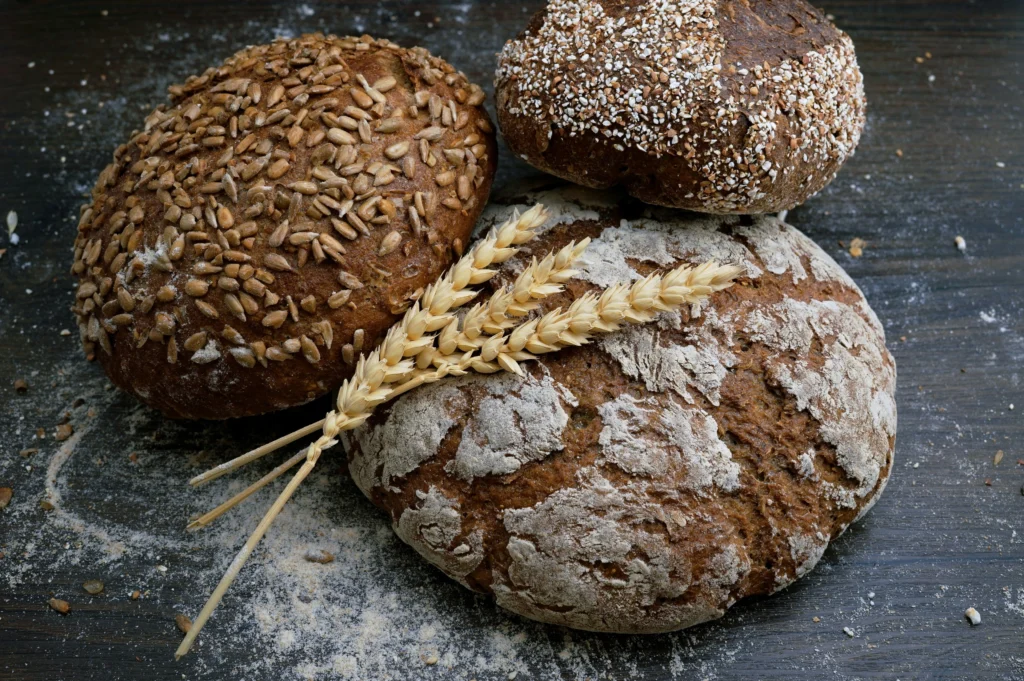Table of Contents
Homemade sandwich bread is a true delight. It’s fresh, soft, and full of flavor. Whether you’re making the perfect grilled cheese or enjoying a slice with coffee, this recipe is perfect for any time.
By making your own bread, you control the ingredients. This means you get freshness and quality that store-bought can’t match. Plus, it’s cheaper, making it great for busy families. Get ready to wow your family and friends with this homemade bread.
Key Takeaways
- Discover the joy of homemade sandwich bread with a foolproof recipe
- Enjoy the freshness, softness, and customizable flavor of your own bread
- Save money and control the quality of ingredients by baking at home
- Wow your loved ones with the exceptional taste and texture of your homemade loaf.
- Versatile recipe suitable for a variety of sandwich creations
Essential Ingredients for Perfect Sandwich Bread
Making the perfect sandwich bread is an art. It begins with the right ingredients. The key is bread flour and active dry yeast. Each plays a big role in the bread’s texture, flavor, and success.
Understanding Different Types of Flour
Flour is the foundation of excellent sandwich bread. Bread flour is best because it makes the bread sturdy yet soft. All-purpose flour works too, but it might make the bread denser. Try different flours to see what you like best.
The Role of Yeast and Fermentation
Active dry yeast is crucial for a light, airy bread. It eats the dough’s sugars, making the bread rise. This process also makes the bread taste better, so let the dough proof well.
Optional Add-ins for Enhanced Flavor
While basic ingredients are key, you can also add special touches. Think about adding herbs, spices, cheese, or dried fruits. These extras can make your bread truly special and enhance your sandwich.
Equipment and Tools You’ll Need
To bake perfect sandwich bread at home, you’ll need some basic tools. A stand mixer can make mixing and kneading easy, but it’s not required. You can mix and knead the dough by hand if you don’t have a stand mixer.
A loaf pan is crucial for making sandwich bread. It gives your bread the classic rectangular shape, perfect for slicing and making sandwiches. A dough scraper is also useful. It helps you transfer the dough and shape it into the pan.
Accurate measuring is key for consistent results.Ensure you have measuring cups and spoons on hand. A digital kitchen scale is also helpful for precise measurements, especially for ingredients like flour.
Other Useful Bread Making Tools
- Mixing bowls
- Wooden spoon or dough whisk
- Parchment paper or silicone baking mat
- Serrated knife for slicing the bread
- Oven thermometer to ensure accurate baking temperatures
While these bread making tools can make things easier, the most important thing is to have the right mindset and patience. With the right techniques and a reliable recipe, you can make delicious homemade sandwich bread.It will wow your family and friends..
Step-by-Step Sandwich Bread Making Process

Making the perfect sandwich bread is a fun and rewarding task. It involves bread kneading, dough proofing, and loaf shaping. Each step is key to getting the best bread baking tips. Let’s explore the steps to help you master sandwich bread making.
Mixing and Kneading Techniques
Start by mixing dry ingredients like flour, salt, and any extra flavors in a big bowl. Then, add wet ingredients like water, yeast, and oil or butter. Mix until the dough comes together. Knead the dough for 10 minutes to make it soft and chewy.
Proper Proofing Methods
After kneading, put the dough in a lightly oiled bowl. Cover it and let it rise in a warm, draft-free spot. This dough proofing step, or first rise, takes about an hour. It should double in size.
Punch down the dough to remove any air bubbles.. Then, shape it into a loaf and put it in a greased bread pan. Let it rise again for 30-45 minutes.
Shaping Your Loaf
Deflate the dough and shape it into a rectangular loaf. Tuck the ends under for a smooth surface. Place it in a greased bread pan, cover, and let it rise until it’s just above the pan rim. This loaf shaping step is important for a well-shaped sandwich bread.
Baking Temperature and Timing
Preheat your oven to 375°F (190°C). Put the dough in the oven after its second rise. Bake for 30-35 minutes, or until the crust turns golden. Keep an eye on the bread and adjust as needed for a perfect bake. Allow it to cool completely on a wire rack before slicing and enjoying.
Troubleshooting Common Bread Making Problems
Baking homemade sandwich bread can be a fun experience, but it comes with its own set of challenges. Whether you’re an experienced baker or just starting out, you might face some common issues. Don’t worry, we’ve got some expert advice to help you solve these problems.
Fixing Dense Bread
If your sandwich bread is dense and heavy, there could be a few reasons. Overworking the dough, using the wrong flour, or not letting it proof enough can make it dense. To fix this, knead the dough for less time, use a lighter flour like all-purpose or bread flour, and make sure it proofs well before baking.
Preventing Dry Bread
- Overbaking often makes bread dry and crumbly. Keep an eye on the oven and use a digital thermometer to check the internal temperature. It should be between 190-205°F.
- Not enough moisture can also cause dryness. Adjust the water or milk in your recipe to get the right moisture balance.
- Storing bread properly is crucial to keep it fresh. Use an airtight container or bag to prevent it from drying out.
Troubleshooting Uneven Rising
If your bread doesn’t rise evenly, it might be due to a few reasons. Make sure your yeast is fresh and your kitchen is at the right temperature for proofing. Also, knead the dough well to develop the gluten, which helps it rise evenly.
| Common Bread Making Problems | Possible Causes | Solutions |
| Dense, Heavy Texture | Overworked doughIncorrect flour typeInsufficient proofing time | Reduce kneading timeUse lighter flour (all-purpose or bread flour)Give the dough extra time to rise. |
| Dry, Crumbly Bread | OverbakingInsufficient hydrationImproper storage | Monitor baking time and internal temperatureModify the water or milk quantity in the recipe.Store bread in an airtight container |
| Uneven Rising | Inactive or old yeastUnsuitable proofing temperatureInadequate gluten development | Use fresh, active yeastEnsure optimal proofing conditionsKnead the dough thoroughly |
By tackling these common bread making problems, you can improve your homemade sandwich bread. Remember, trying new things and being patient are key to mastering bread baking. With these tips, you’ll be making perfect loaves every time.
Creating the Perfect Sandwich Bread Texture
Making the perfect sandwich bread is a mix of science and art. It’s all about getting the right texture. You want your bread to be soft and tender inside, with a crisp crust.
Achieving a Tender Crumb
To get a soft crumb, focus on gluten development. Knead the dough well to strengthen the gluten strands. Be gentle when shaping to keep the air pockets that make the bread soft.
Crust Development Secrets
For a golden, crisp crust, watch how you bake. Brush the loaf with egg wash or milk for shine. Try different baking temperatures and times to get the perfect crust.
Moisture Control Tips
- Adjust your ingredient ratios for the right moisture. Too much liquid makes it soggy, too little makes it dry.
- For consistent heat, use a baking stone or steel.
- Get an oven thermometer for accurate temperature.
Mastering soft bread texture, bread crust techniques, and moist bread tips will help you make amazing sandwich bread. It will turn out soft, tender, and full of flavor.
Storage Tips and Shelf Life
Maintaining the freshness of your homemade sandwich bread is essential for savoring its flavor. You can store it at room temperature, in the fridge, or freezer. Each method has its own way to keep it fresh longer.
Storing at Room Temperature
For the best taste and texture, eat your bread within 2-3 days at room temperature. Store it in a bread box or a paper bag. This helps keep it soft and crispy.
Refrigerating for Longer Shelf Life
For longer freshness, the fridge is a good choice. Wrap it tightly in plastic or a resealable bag. It can last up to 1 week. But, it might get less soft and slightly stale.
Freezing for Maximum Freshness
Freezing is the best way to keep your bread fresh. Wrap it in plastic or foil and it can stay fresh for up to 3 months. Just thaw it at room temperature or warm it in the oven to get back its original texture.
| Storage Method | Shelf Life | Best Practices |
| Room Temperature | 2-3 days | Store in a bread box or paper bag |
| Refrigerator | Up to 1 week | Wrap tightly in plastic or place in a resealable bag |
| Freezer | Up to 3 months | Wrap in plastic or foil, thaw at room temperature or warm in the oven |
By using these storage tips, you can enjoy your homemade sandwich bread for a long time. Always check for mold or bad smell before eating.
Variations for Different Dietary Needs
Whether you’re gluten-free, prefer whole grains, or follow a low-carb diet, you can still make delicious homemade sandwich bread. This section will show you how to adapt recipes for your dietary needs. This way, everyone can enjoy the perfect slice.
Gluten-Free Options
For gluten-free sandwich bread, use a mix of gluten-free flours like rice, tapioca, and xanthan gum. You might need to adjust the liquid to get the right dough. Also, the proofing and baking times might be different from the original recipe.
Whole Grain Alternatives
To make a healthier whole grain sandwich bread, mix in whole wheat, oat, or other whole grain flours with all-purpose flour. Find the right mix of flavors and textures by experimenting. Remember, the dough might take longer to knead and proof because of the extra fiber.
Low-Carb Modifications
For a low-carb version, try almond, coconut, or other low-carb flours. These flours need more eggs or binders to work right. Adjust the amounts and baking times to make a loaf that’s both tasty and low in carbs.
FAQ
What are the key ingredients for making the perfect sandwich bread?
To make the perfect sandwich bread, you need bread flour, yeast, water, sugar, salt, and butter or oil. Understanding how each ingredient functions is key. For instance, bread flour provides texture, while yeast is responsible for the bread’s rise.
How do I ensure my bread rises properly during the proofing process?
For a light and airy bread, proofing is key. Temperature, humidity, and how long you let it proof all matter. Make sure the dough doubles in size and proof in a warm, draft-free spot.
What’s the best way to shape the dough into a loaf for baking?
Properly shaping the dough is essential for achieving the right texture. Gently deflate the dough, roll it into a tight log, and seal the seams. This helps make a loaf with a consistent crumb.
How can I achieve a soft, tender crumb in my homemade sandwich bread?
The crumb’s softness comes from kneading, proofing, and baking. Don’t over-knead, let it proof well, and bake at the right temperature. These steps will give you a soft crumb.
What are some tips for preventing a tough, dry crust on my homemade bread?
To avoid a tough crust, control your baking environment. Keep it humid and at the right temperature. Brushing the loaf with water or milk and covering it can also help.
How long can I expect my homemade sandwich bread to stay fresh?
Storing your bread right keeps it fresh. At room temperature, it lasts 3-5 days. In the fridge, it can last a week. Freezing extends its life to months.
Are there any gluten-free or low-carb options for making sandwich bread at home?
Yes, there are gluten-free and low-carb options. You can use gluten-free flour blends or almond or coconut flour. These alternatives cater to different diets.



1 thought on “The Ultimate Sandwich Bread Recipe for Every Occasion”
Comments are closed.